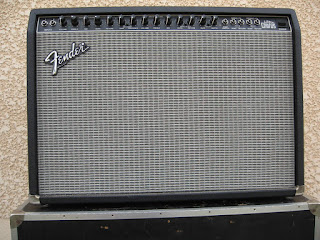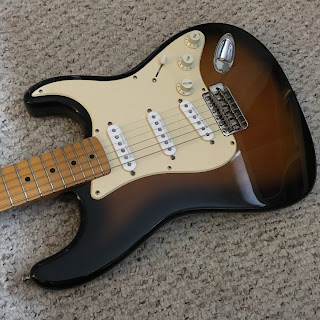A good guitar always has an interesting story
A very long time ago, I was in a band where the lead singer played rhythm guitar. He was no where near even a moderate gear head, a guitar to him was a tool. His guitar at the time was an Ibanez that had a H-S-H pickup configuration and a Floyd rose type of locking tremolo. For a guy that would use a guitar as a songwriting tool, I don't know how he ended up with it, probably some pressure from a sales clerk, I imagined. He was pretty heavy handed, and with a little suggestion he switched from .09 strings to .10's, to prevent string breakage. His picking hand kind of rested on the floating bridge, so at times, things got warbly out of tune here and there.
Floyd Roses bridges are great, and believe me, not all that long before that Ibanez style guitar would have been on my "must have" lists for guitars. But when you break a string, it's a few more steps to fix the situation. My singer, even with heavier strings, could really be tough on them. Compound that with a fairly heavy gig schedule, he was breaking enough strings that I bought a box of D'Addario's. With our heavy gigging schedule we went through them in less than a year.
I suggested I build him a guitar that would be more fitting to his style, not a shred machine, but truly a great rhythm guitar, that would stay in tune, be less prone to string breakage, and look interesting. He was all game, and while we were both pretty broke, I figured buying parts from craigslist and ebay would cut the costs alot, and final assembly would be the biggest expense overall.
I started with a standard strat style body, it was pretty heavy, so I assumed it was ash. It was already finished in gloss black, with some dings in it. For $25 it was a great EBay find. Sanding down the electronics cavity I realized it was solid wood, not a plywood body. I scuffed the gloss black to a satin appearance, to make it look a bit rat-rod ish. Taking my Dremel fitted with a conical grinding bit, I started to carve scar or vein like grooves into the body. I made sure that they would begin or end at the edge of the pick guard. After I filled these exposed veins with flat black modeling paint, it had a rough rugged look to it. My next idea was to get ultra violet paint (the kind that only appears under black lights) and then go over the grooved areas again with that. We played a few clubs where the sound guy ran the lights, and for some reason they had a "black light" mode in their lighting rigs. the final touch would be getting a glitter-ish paint, where a small amount of glitter or metal flake was suspended in a clearcoat, and then go over the UV paint with that, I got the idea of from one of the bartenders at one of those clubs. Her lipstick lit up in the black light, unbeknownst to her, and she always had some of that heavy glitter that she applied over her lipstick. My singer loved the idea. There were some Ibanez guitars that had a carved in to the body Spider web style, and this was a bit more organic like feel to that same concept.

Electronics wise, My idea was a single humbucker in the neck. Even in the studio when a producer or engineer heard his guitar they would ask why his sound was so bass heavy. He always played on the neck pickup for it's fuller sound. They would always get him to switch to the bridge pickup in the studio. During sessions he'd switch it back, either intentionally or accidentally with his strumming. During mixes they'd be scratching their heads, trying to clean up his sound. Eventually they would give up, in more than one case the engineer would confide in me that he was glad I did so many guitar tracks; if we were playing the same kind of guitar part, they just mixed our singer's rhythm guitar out. When his parts were front and center, they fixed them, they did their best to make it sound good.
A single humbucker wouldn't have alot of tonal options, but I figured getting a 3 way toggle; with the 1st position, just the front coil, the 2nd a full humbucker, and the 3rd, the rear coil. Again, thankfully our singer didn't really think of this as odd. The only other control would be a volume knob. It made for a simple instrument. It still had some tonal options, albeit limited to rhythm sounds.
Since our singer had kind of big hands, he liked the Ibanez slim line neck, but it seemed he pulled too hard on it, and would slide strings almost off the fretboard. I was hoping a rounder neck would be a better fit. I went on a search for a fairly large radius neck. Again, on Ebay I found one, it had no logos or any markings, but based on the headstock shape it was either a Peavey, or an allparts item. The rosewood fingerboard was nice, and all the frets were in good shape. For another $25 it was a deal. I primed the headstock, and painted it flat black to match the guitar body.
The body was routed for a standard strat style tremolo, so I was limited in choices there. Ideally I wanted to find one with roller saddles, but no luck. Ebay again provided a chrome bridge, with heavy block saddles by WD, still in the box, for $35.
I was only into the guitar for $85 or so, when I showed my singer the body, and he was excited to see it, as well as the neck, He gave his approval of the progress thankfully. A few weeks later on I said if he could throw me a couple of bucks, I could finish off this guitar for him.
Admittedly, we were all broke, but at this point my singer said "I never said I wanted you to build me a guitar" I don't know if it was a money issue, or something else. I kind of assumed after talking about it, it was a go. After showing him the body and parts he was excited, so again, I though he wanted me to do this. But when it came time to put in some money on his end, not only was I vetoed, I was told it was never approved. Maybe I misunderstood. Regardless I now had a project guitar in the works, and not alot of money to finish it off.
I thought of selling the neck and bridge, I could re-coup some of that. The body was now all caved up, and in complete flat black. I doubt that would have sold at all. I decided this would be a long term project for me. If I completed it, I'd make it a guitar for me. If my singer wanted it afterwards, I'd sell it to him for cost, plus assembly.
Eventually I left that band. One night under the influence of some good beer I hung the guitar up, and grabbed a few cans of spray paint I had. My MGB was in the middle of restoration, and I had a good selection of various paints for all the parts I was doing for it. Silver, a red with a metallic in it, as well as a black with a slight metal flake, I'd drink a bit, spray a bit, let it dry, and then repeat the process. by the end of the night, It looked cool. With all the grooves and scars, it kind of got to be known as "scarface"
Sound wise I wasn't going to do a single neck pickup anymore. The electronics 2 humbuckers from a PRS SE Tremonti, mounted on a single ply black pickguard. I did a single volume knob, and a three way switch. To finish things off, I got a set of used G&L Tuners from my local music store for about $35. After finally getting it together, it played pretty nice. The pickups weren't my fave though. They lacked a bit of bottom end. Im sure in the PRS the were designed for they would be ok, but not this parts caster. It kind of got stuck in that mode and I forgot about it. Eventually I replaced the pickguard with a single HB and volume knob, and went with a guitarfetish VEH pickup, which is kind of like a Van-halen ish humucker. I've hand some other pickups from guitarfetish, and I have to say it's a your mileage may vary. The hum cancelling single coils in my tele, are just Ok. This humbucker is really nice tho!
With the single humbucker, the guitar actually came to life. It has alot of punch, clarity, low end and overall sounds great. For a single pickup guitar there's still plenty of tones in there. The neck is a bit fatter than what I usually play, but it does feel great. Unplugged it's fairly bright, with plenty of snap. I blocked the Tremolo, and it adds a lil more sustain, but stays in tune really well. It's a bit heavy, bit that's the only downside.
It's my go to "around the house" guitar. It's great for just running to the computer and doing a demo, super easy to dial in a tone and just go. At the time I felt kind of let down when my singer pulled the plug on doing it, I really think it would have been a good guitar for him, but I ended up with a great inexpensive guitar.





























